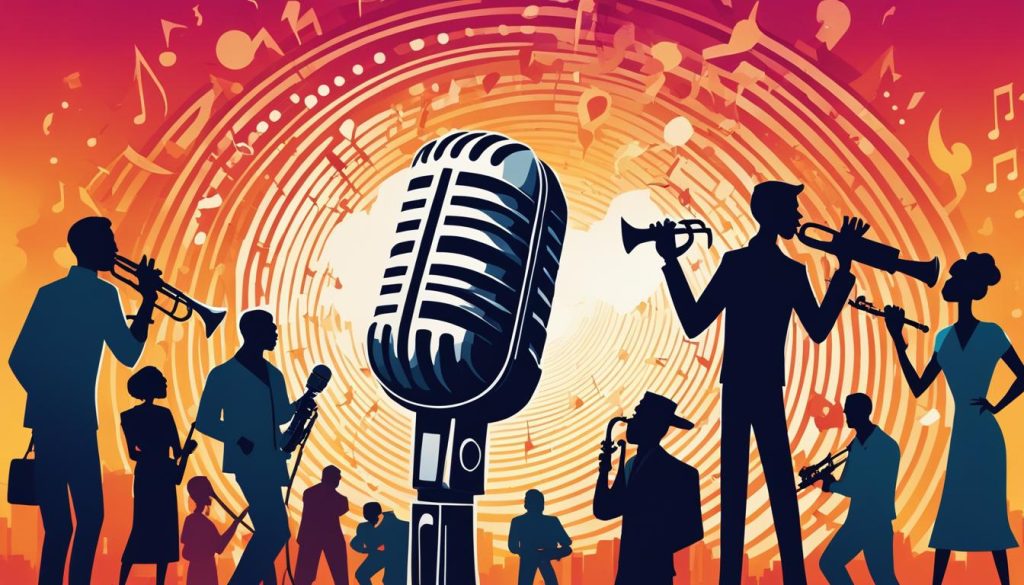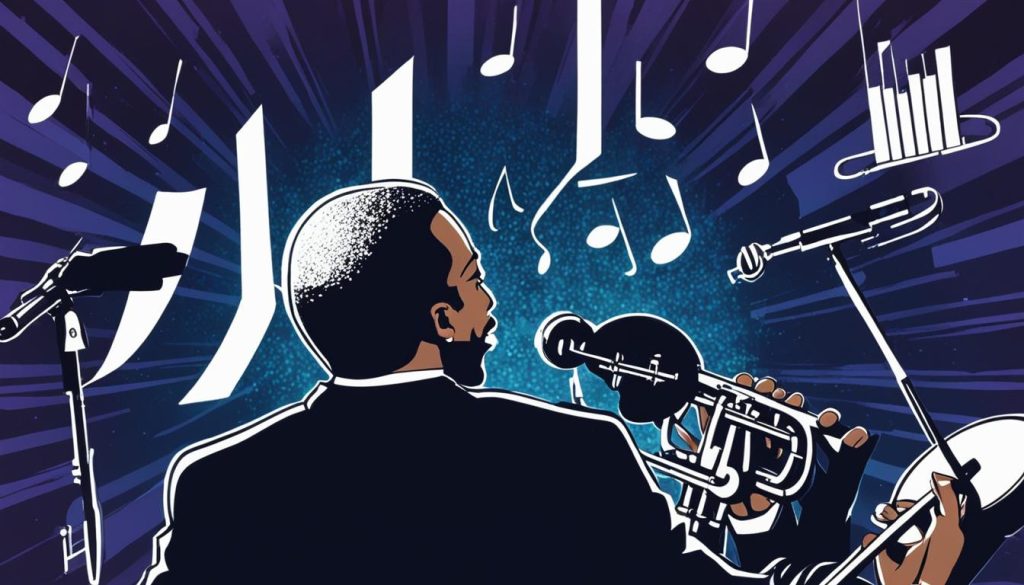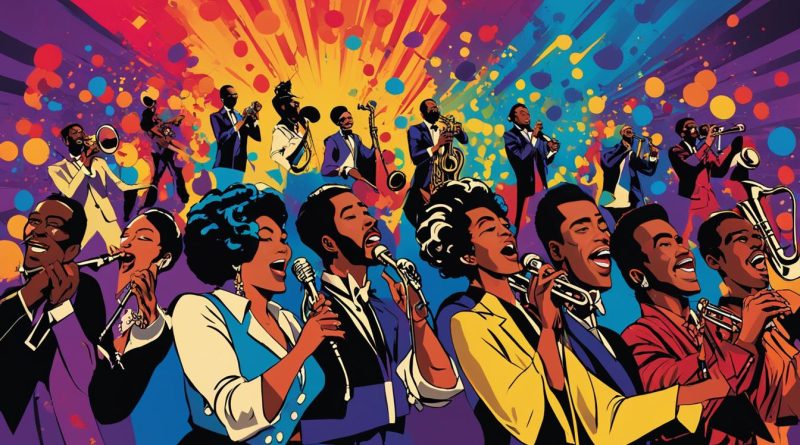Exploring the Legacy of The Jazz Singer Era
The Jazz Singer is widely regarded as a monumental film that left an indelible mark on music, film, and cultural heritage. This iconic movie premiered in 1927 and is recognized as the first feature-length motion picture with synchronized sound.
The Jazz Singer revolutionized the entertainment industry, introducing a major technological breakthrough and capturing audiences’ hearts worldwide. Its impact on popular culture and music is felt to this day, almost a century later.
In this section, we will take a closer look at The Jazz Singer era and the fertile ground that it broke for jazz and popular music. By exploring the film’s cultural significance, we can gain a deeper understanding of its lasting impact.
Key Takeaways
- The Jazz Singer was a groundbreaking film that had a profound impact on music, film, and cultural heritage.
- It is recognized as the first feature-length motion picture with synchronized sound, ushering in a new era of technological advancements in cinema.
- The Jazz Singer sparked controversy with its use of blackface and portrayal of Jewish identity, but its cultural impact and influence on music and performance continue to resonate.
- The Jazz Singer is still considered a pivotal cultural artifact and is widely regarded as one of the most influential films of all time.
The Jazz Singer: Pioneering Sound in Cinema
When “The Jazz Singer” premiered in 1927, it marked a significant milestone in the history of cinema. Not only was it the first feature-length motion picture with synchronized sound, but it also represented a technological breakthrough that would forever transform the art form.
The audio innovation used in “The Jazz Singer” was a system called Vitaphone, which synchronized sound recordings with the on-screen action. Through Vitaphone, dialogue, music, and sound effects became integral parts of the film, allowing for a more immersive and engaging experience for viewers. This breakthrough not only enhanced the storytelling aspect of cinema, but it also opened up new possibilities for experimentation and creativity.
Al Jolson’s unforgettable performance in “The Jazz Singer” as the son of a Jewish cantor who dreams of becoming a jazz singer showcased the power of this new technology. His soulful renditions of popular songs like “Toot, Toot, Tootsie! (Good-bye)” and “Blue Skies” captivated audiences and helped cement the film’s status as a cultural phenomenon.
“You ain’t heard nothing yet!” – Al Jolson, in “The Jazz Singer.”
The success of “The Jazz Singer” sparked a race among studios to incorporate sound into their movies. This technological advancement led to the formation of new production studios and sound engineering companies, leading to a boom in the entertainment industry.
Overall, “The Jazz Singer” represented a technological triumph that reshaped the future of cinema and paved the way for modern-day blockbusters. The unforgettable performance by Al Jolson and the film’s pioneering use of synchronized sound cemented its cultural legacy, making it a must-see for film enthusiasts and casual viewers alike.
Cultural Impact and Controversies Surrounding The Jazz Singer
The Jazz Singer made a profound impact on cultural identity, both at the time of its release and in modern times. The film’s use of blackface has been a subject of controversy, as it reinforced existing stereotypes and negative attitudes towards African Americans. While the use of blackface was prevalent in the entertainment industry at the time, it remains a contentious issue today, and The Jazz Singer’s contribution to this problematic history cannot be ignored.
Furthermore, The Jazz Singer’s portrayal of Jewish identity was groundbreaking, as it provided a rare depiction of Jewish characters in mainstream cinema. However, the film’s representation of Jewish culture was plagued by stereotypes and caricatures, perpetuating negative images of the Jewish community. It is essential to view the film’s depiction of Jewish identity within its historical and cultural context, acknowledging the progress it represented while recognizing its problematic elements.
The Jazz Singer sparked significant discussion and debate about cultural identity and representation, both in its initial release and in contemporary times. By exploring the social and historical context of the film’s reception and discussing the controversies surrounding it, we can gain insight into its broader cultural impact and significance.
Reception of The Jazz Singer

| Reception | Response |
|---|---|
| Industry professionals | Mixed responses; technological breakthrough celebrated but blackface and Jewish stereotypes criticized |
| General public | Enthusiastically embraced, became a box office success, and redefined the way audiences experienced film |
| Social impact | Ignited debate about representation and cultural identity, exposing the need for more diverse and nuanced depictions of marginalized communities |
“The Jazz Singer challenged existing norms and sparked an essential conversation about what cinema could be. While the controversies surrounding the film cannot be disregarded, its impact on popular culture and its lasting legacy in music and performance is undeniable.”
The Enduring Influence on Music and Performance
In the realm of music and performance, “The Jazz Singer” has left an indelible legacy that has endured for over a century. The film’s groundbreaking integration of popular music and jazz into its soundtrack established a new standard for sound and music in cinema.
The use of jazz in “The Jazz Singer” is particularly noteworthy as it helped to promote the genre and introduce it to a wider audience. The soundtrack, featuring unforgettable performances by Al Jolson, revolutionized the way in which music was incorporated into films. It set a new standard, not only for feature-length films but for the entertainment industry as a whole.
Moreover, “The Jazz Singer” has had a profound impact on subsequent generations of musicians and performers. Its influence can be seen in the way in which popular music has evolved to incorporate jazz and other styles, as well as in the use of music in performances. “The Jazz Singer” was not just a film; it was an innovation that transformed the course of music and performance history.
Today, “The Jazz Singer” continues to inspire contemporary artists and serves as a reminder of the profound impact of innovation and creativity on cultural heritage.
Jazz and Popular Music in “The Jazz Singer”
“The Jazz Singer” is widely regarded as a milestone in the use of popular music in films. Its soundtrack featured a diverse range of music, including jazz, popular songs and religious hymns, and showcased the versatility and depth of music as a storytelling medium.

Additionally, the inclusion of Al Jolson’s unforgettable performance of “Mammy” further propelled popular music into mainstream culture and paved the way for future musical films.
The Impact on Performance
The influence of “The Jazz Singer” also extends to the realm of performance, where its impact can be seen in the integration of music as an essential element of live shows. The use of music to enhance performances has become ubiquitous in modern entertainment, from theatre productions to concerts.
“The Jazz Singer” helped to promote the integration of music into theatre and performance, and its legacy can be seen in performances to the present day.
Conclusion
In conclusion, “The Jazz Singer” remains an iconic film that has left an indelible mark on popular culture. Its revolutionary use of synchronized sound paved the way for future technological breakthroughs in cinema. However, the film’s portrayal of blackface and Jewish identity sparked controversies and societal repercussions. By examining the film’s cultural impact and reception, we can gain a deeper understanding of its lasting significance.
Moreover, “The Jazz Singer” has had a profound influence on music and performance. Its use of jazz and popular music changed the musical landscape and inspired future generations of artists. The film’s legacy continues to resonate today, shaping the art forms we enjoy. Whether as a cultural artifact or technological breakthrough, “The Jazz Singer” remains a pivotal moment in entertainment history.
FAQ
What is “The Jazz Singer” era?
The “The Jazz Singer” era refers to the period in film and music history that stems from the release of the iconic film “The Jazz Singer” in 1927. This era is characterized by the revolutionizing impact of the first feature-length motion picture with synchronized sound on the entertainment industry and popular culture.
How did “The Jazz Singer” revolutionize the film industry?
“The Jazz Singer” revolutionized the film industry by introducing synchronized sound to motion pictures. Prior to this film, movies were silent and relied on live musical accompaniment. The technological breakthrough of synchronized sound paved the way for the future of cinema, transforming the way stories were told and experienced on the silver screen.
Who was Al Jolson and what was his role in “The Jazz Singer”?
Al Jolson was a renowned entertainer and actor who played the lead role in “The Jazz Singer.” He portrayed a young Jewish man torn between his passion for jazz and his family’s traditional values. Jolson’s electrifying performance and his ability to bring the magic of sound to the audience made him a synonymous figure with the success of “The Jazz Singer.”
What controversies surrounded “The Jazz Singer”?
“The Jazz Singer” sparked controversies due to its use of blackface in portraying African American characters. Despite its significance in pioneering sound in cinema, the film has faced criticism for perpetuating racial stereotypes. Additionally, the portrayal of Jewish identity in the film raised debates about representation and authenticity.
How did “The Jazz Singer” impact music and performance?
“The Jazz Singer” had a profound influence on music and performance. The film introduced jazz and popular music to a broader audience, forever changing the musical landscape. It also inspired future generations of artists to incorporate music into their performances, leading to the birth of the modern musical and shaping the way we experience music in films and theater today.
What is the enduring legacy of “The Jazz Singer”?
The enduring legacy of “The Jazz Singer” lies in its status as a cultural artifact that changed the entertainment landscape. From its groundbreaking use of synchronized sound to its impact on music and performance, the film continues to be studied and revered as a pivotal moment in film history. Its influence can still be seen in contemporary artists who draw inspiration from its innovations.
